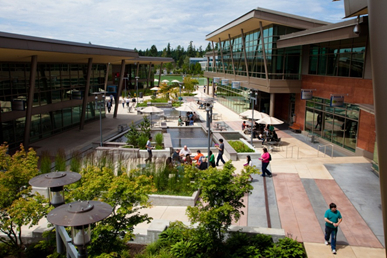Blog Post
What Is Microsoft Doing at Greenbuild?
Microsoft releases initial results from an energy management pilot project that uses the MS campus as a test bed.

I had the privilege Tuesday night to attend a dinner hosted by Microsoft Corp. here in Toronto. When I told my colleagues where I was heading, they said, "What is Microsoft doing at Greenbuild?"
If you saw my earlier post about Panoptix or attended the Greenbuild closing plenary, it might be a little easier to make the connection. Information technology is becoming an ever more important part of green building, particularly when it comes to energy and water management. Of course, data has been a big part of green building from the beginning. It's finding ways to make it usable that we're still working on.
Cross-platform data analysis
And Microsoft is one of the companies working on it. In part this is financial: its cloud-based Azure database platform is used by JCI's new Panoptix tool, and Microsoft would obviously like more companies to use it as well. (Microsoft is not planning to directly enter the energy management software market.) But it's also part of meeting the company's own carbon commitments--one good reason they were doing a pilot project using their own campus as a test-bed facility in a project with Lawrence Berekely National Lab (LBNL) and Accenture (which does building management consulting).
Microsoft took the occasion of Greenbuild to release a paper (click for PDF) along with LBNL and Accenture about that pilot project, which is an attempt to take many different buildings of different ages and building management system sophistication levels and streamline all their data into one data set stored in the cloud. This is not a building management system: the original automation systems, of whatever vintage and brand, remain in place. These "smarter building" systems slice, dice, and present the data uploaded to them by the building management systems.
That data set also includes real-time weather data and building occupancy statistics. Now Microsoft is developing algorithms that take all this information and learn about how buildings respond to weather--not just climate--as well as occupancy on a really granular level. This is really cool stuff with a lot of potential for providing us with better predictive energy modeling as well as greater ability to get building occupants invested in controlling their own energy use.
Start making sense
The pilot project also focused on getting data to make more sense for facility managers. The systems can diagnose, prioritize, monetize, and alert the operations staff about problems before anyone complains--and about problems no one would notice to complain about. This "smart building" idea, according to the paper and a Microsoft blog post about it, can pay for itself in 18 to 24 months and offer energy savings of 10%–30%--without any capital improvements or retrofits.
SUPPORT INDEPENDENT SUSTAINABILITY REPORTING
BuildingGreen relies on our premium members, not on advertisers. Help make our work possible.
See membership options »Clearly, sealing and insulating your building is also important, but if you streamline your ability to manage your energy data before undertaking a big retrofit project, you might even be able to diagnose and prioritize the most cost-effective retrofits before you get started.
I'll be talking more about this pilot project in an article on occupant engagement in next month's Environmental Building News. Meanwhile, what do you think of Microsoft's idea of saving 10%–30% on energy without so much as picking up a pry bar?
Published October 6, 2011 Permalink Citation
(2011, October 6). What Is Microsoft Doing at Greenbuild?. Retrieved from https://www.buildinggreen.com/blog/what-microsoft-doing-greenbuild



Add new comment
To post a comment, you need to register for a BuildingGreen Basic membership (free) or login to your existing profile.